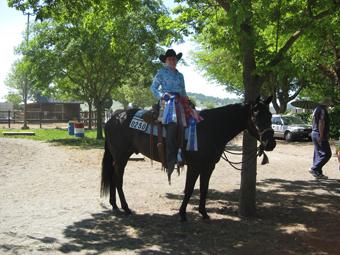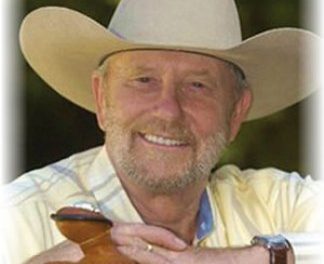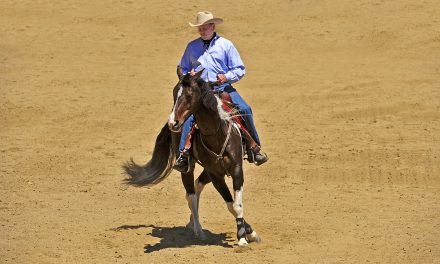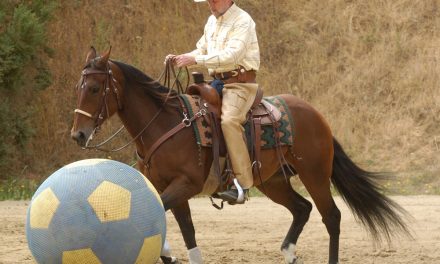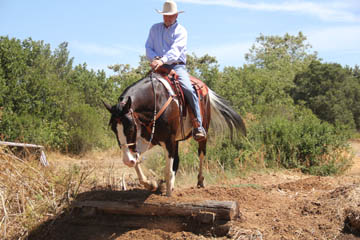TRAINING THE WESTERN PLEASURE HORSE

Lacey with Ribbons
This is the second article in our series on the western pleasure disciplines. These articles are intended for riders who want to get into western pleasure and can’t go to a training barn or who would like to do it on their own, as there are many shows where an amateur or novice can participate. My previous article discussed the selection of a horse. This article discusses a bit about the history of western pleasure, what we’re looking for in the western pleasure horse, and what can be done to train a horse for a western pleasure show.
History
Western pleasure was introduced in the late 1940s and early 1950s. Ranch hands would bring their best riding horses to the rodeos. Each ranch hand had two, three, or even a string of horses for working cows or riding fence lines. They always brought the best horses to ride. The horse’s gait was comfortable and relaxed, and it was a pleasure to ride the horse.
What we’re looking for in the western pleasure horse
According to the American Quarter Horse Association (AQHA) rule book, “A good pleasure horse has a free flowing stride of reasonable length in keeping with his conformation. He should cover a reasonable amount of ground with little effort. Ideally, he should have a balanced, flowing motion, while exhibiting correct gaits that are of the proper cadence. The quality of the movement and the consistency of the gaits is a major consideration. He should carry his head and neck in a relaxed natural position with his poll level or slightly above the level of the withers.”
How I have trained for a western pleasure show
When I was getting my horse ready to show in a western pleasure show, I spent the first six months of preparation getting the horse quiet and soft, and also suppling him and working on shoulder control. I also worked on halts, the trot, the extended trot, a quiet slow lope, and an extended lope.
Going into the last six months of training, I work on finishing the package by looking for self-carriage and getting consistency in that carriage. When we start teaching horses to carry themselves in any discipline, but particularly in western pleasure because it is such a slow gait, we have to make sure the horses is able to carry himself more than two or three strides at a time. It takes time to develop the top line, which involves teaching the horse to use his hind quarters. We want a rear wheel drive, meaning the horse’s stride comes from behind.
Training exercises
Once I have established the basics and am starting to refine the gaits and develop the quiet gaits, there are some exercises I do to improve carriage.
1. Getting his weight back. If my horse is traveling on the forehand, meaning the horse is dumping his weight onto his front end, I stop and back the horse. This gets his weight to shift back over the hindquarters. As I back, I roll the horse over his hocks–which is like a turn on the haunches. Then I ask him to go forward with the weight still shifted back. By rolling over the hocks and then going forward with his weight back, the horse will go up under himself.
2. Lateral work. Once I have control of the shoulders and hips, I like to do lateral work. I start putting together side-passing and leg yielding. These help teach the horse self carriage and to be supple.
3. Haunches-in. With this exercise, the horse’s front end stays straight and his hind quarters tip toward the inside. I use it to get more control of the hind quarters and also control the horse’s speed. In the show ring, though, we don’t want to lope around with the horse’s hip to the inside; the horse’s nose, shoulders, and hips need to be aligned, and he needs to be traveling straight down the rail.
A few more training notes
Patience is a key to training any horse but especially with a western pleasure horse. Consistency is also very important. For example, if you have a horse that is a little long in the back, it may take a lot more patience and consistency on your part to get the horse to start carrying himself properly and using his back more. Follow-through is also very important. If you ask your horse to move his hips in with a soft cue, make sure the hip goes to the inside.
Next time I will discuss western pleasure equipment and dress requirements.
Charles Wilhelm is a world-renowned and respected trainer and author from California. Please visit his Web site at cwtraining.com.

